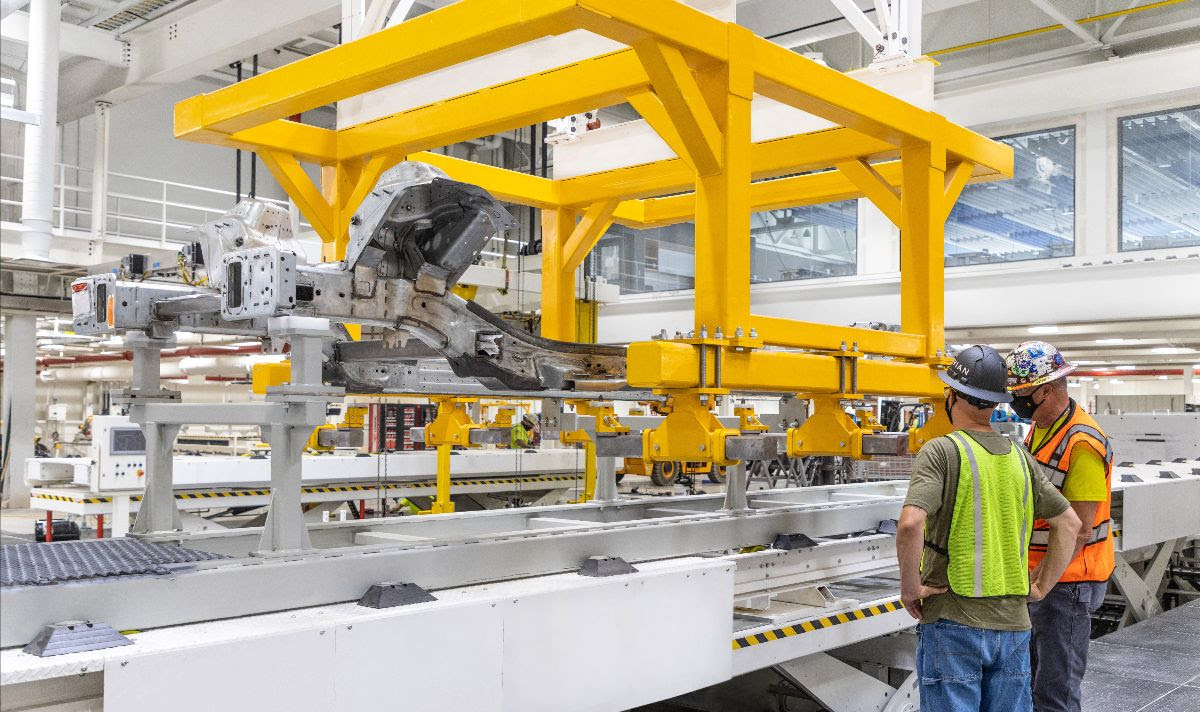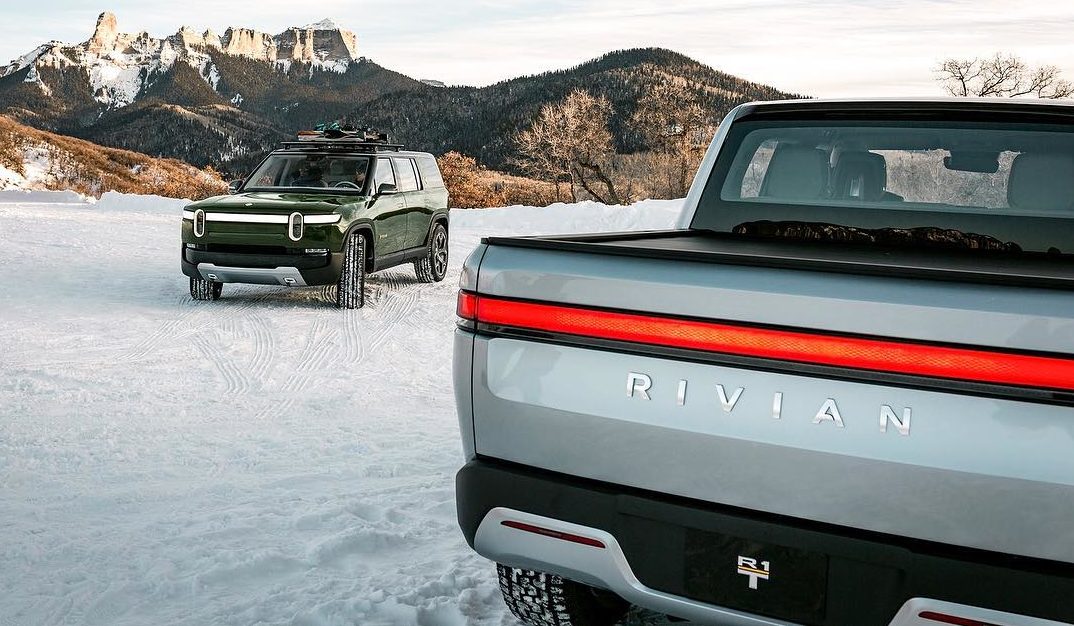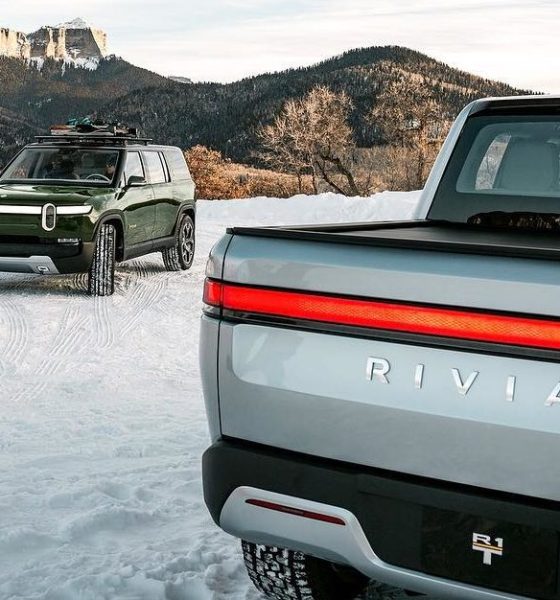Rivian has revealed the delivery dates for its R1T pickup truck and R1S Sport Utility Vehicle.
Both of its all-electric vehicles will debut in Summer 2021, but the R1T truck will make its way to customers before the R1S SUV will.
Rivian announced that the R1T would begin deliveries in June 2021, meaning the company’s first all-electric vehicle is less than a year away from making its way to reservation holders.
Additionally, the R1S SUV will begin deliveries in August 2021, just two months after the truck starts arriving to customers.
- Rivian R1T truck at the NY Auto Show 2019. | Image: Dacia J. Ferris/Teslarati
- Rivian R1S SUV at New York Auto Show 2019. | Image: Dacia J. Ferris/Teslarati
The delivery dates were both announced in a press release from Rivian on July 24, where the company stated that its pilot production line is coming together at the company’s production plant in Normal, Illinois.
“This week at our plant in Normal, IL, the work of thousands of Rivian team members comes together as our pilot production line begins running,” the company’s press release said.
“This important milestone brings us another step closer to our full production launch. It also allows us to more precisely estimate delivery timing.”

In April, Rivian announced that its production lines would not begin manufacturing either of its planned vehicles until 2021 due to the COVID-19 pandemic. Evidently, that timeline is still accurate, judging by the company’s announcement of when deliveries would begin.
Moving forward, Rivian’s main priorities are to keep its team safe while it continues to develop its manufacturing facility. In the coming months, the company also plans to let reservation holders configure their R1T or R1S, and give updates on the charging infrastructure it plans to implement for its vehicles.
The R1T will compete with upcoming electric pickups like the Tesla Cybertruck, Ford F-150 EV, and the GMC Hummer EV. Rivian’s vehicles are geared toward adventurous, outdoor utility while maintaining impressive performance specifications.
Even though the R1T and R1S both have three feet of wading depth, their top of the line 185 kWh models have 400+ miles of range and a 0-60 MPH time of 3 seconds.
The 105 and 135 kWh variants of the R1T and R1S will boast 230+ and 300+ miles of range, respectively.
The R1T will start at $69,000, and the R1S begins at $72,500.
Rivian’s R1T has been on display for prospective owners at multiple “Open House” events across the United States. The electric automaker had plans to visit several new locations, but the dates were postponed due to the pandemic.
Currently, Rivian has several large-scale investors like Ford, Amazon, and Cox Automotive, who are pumping sizeable sums of money into the company’s projects. Rivian recently closed its first investment round of 2020, where it accumulated $2.5 billion in investments.
Most notably, the company’s partnership with e-commerce giant Amazon will have Rivian produce 100,000 electric delivery vans for the company’s push toward more sustainable package transport.
Rivian will have the distinct advantage of being the first EV manufacturer to deliver a fully electric pickup truck, beating Tesla to the market.
Jeff Bezos reveals Rivian’s plans to produce electric vans for Amazon

Elon Musk
Elon Musk and Tesla AI Director share insights after empty driver seat Robotaxi rides
The executives’ unoccupied tests hint at the rapid progress of Tesla’s unsupervised Robotaxi efforts.

Tesla CEO Elon Musk and AI Director Ashok Elluswamy celebrated Christmas Eve by sharing personal experiences with Robotaxi vehicles that had no safety monitor or occupant in the driver’s seat. Musk described the system’s “perfect driving” around Austin, while Elluswamy posted video from the back seat, calling it “an amazing experience.”
The executives’ unoccupied tests hint at the rapid progress of Tesla’s unsupervised Robotaxi efforts.
Elon and Ashok’s firsthand Robotaxi insights
Prior to Musk and the Tesla AI Director’s posts, sightings of unmanned Teslas navigating public roads were widely shared on social media. One such vehicle was spotted in Austin, Texas, which Elon Musk acknowleged by stating that “Testing is underway with no occupants in the car.”
Based on his Christmas Eve post, Musk seemed to have tested an unmanned Tesla himself. “A Tesla with no safety monitor in the car and me sitting in the passenger seat took me all around Austin on Sunday with perfect driving,” Musk wrote in his post.
Elluswamy responded with a 2-minute video showing himself in the rear of an unmanned Tesla. The video featured the vehicle’s empty front seats, as well as its smooth handling through real-world traffic. He captioned his video with the words, “It’s an amazing experience!”
Towards Unsupervised operations
During an xAI Hackathon earlier this month, Elon Musk mentioned that Tesla owed be removing Safety Monitors from its Robotaxis in Austin in just three weeks. “Unsupervised is pretty much solved at this point. So there will be Tesla Robotaxis operating in Austin with no one in them. Not even anyone in the passenger seat in about three weeks,” he said. Musk echoed similar estimates at the 2025 Annual Shareholder Meeting and the Q3 2025 earnings call.
Considering the insights that were posted Musk and Elluswamy, it does appear that Tesla is working hard towards operating its Robotaxis with no safety monitors. This is quite impressive considering that the service was launched just earlier this year.
Elon Musk
Starlink passes 9 million active customers just weeks after hitting 8 million
The milestone highlights the accelerating growth of Starlink, which has now been adding over 20,000 new users per day.

SpaceX’s Starlink satellite internet service has continued its rapid global expansion, surpassing 9 million active customers just weeks after crossing the 8 million mark.
The milestone highlights the accelerating growth of Starlink, which has now been adding over 20,000 new users per day.
9 million customers
In a post on X, SpaceX stated that Starlink now serves over 9 million active users across 155 countries, territories, and markets. The company reached 8 million customers in early November, meaning it added roughly 1 million subscribers in under seven weeks, or about 21,275 new users on average per day.
“Starlink is connecting more than 9M active customers with high-speed internet across 155 countries, territories, and many other markets,” Starlink wrote in a post on its official X account. SpaceX President Gwynne Shotwell also celebrated the milestone on X. “A huge thank you to all of our customers and congrats to the Starlink team for such an incredible product,” she wrote.
That growth rate reflects both rising demand for broadband in underserved regions and Starlink’s expanding satellite constellation, which now includes more than 9,000 low-Earth-orbit satellites designed to deliver high-speed, low-latency internet worldwide.
Starlink’s momentum
Starlink’s momentum has been building up. SpaceX reported 4.6 million Starlink customers in December 2024, followed by 7 million by August 2025, and 8 million customers in November. Independent data also suggests Starlink usage is rising sharply, with Cloudflare reporting that global web traffic from Starlink users more than doubled in 2025, as noted in an Insider report.
Starlink’s momentum is increasingly tied to SpaceX’s broader financial outlook. Elon Musk has said the satellite network is “by far” the company’s largest revenue driver, and reports suggest SpaceX may be positioning itself for an initial public offering as soon as next year, with valuations estimated as high as $1.5 trillion. Musk has also suggested in the past that Starlink could have its own IPO in the future.
News
NVIDIA Director of Robotics: Tesla FSD v14 is the first AI to pass the “Physical Turing Test”
After testing FSD v14, Fan stated that his experience with FSD felt magical at first, but it soon started to feel like a routine.

NVIDIA Director of Robotics Jim Fan has praised Tesla’s Full Self-Driving (Supervised) v14 as the first AI to pass what he described as a “Physical Turing Test.”
After testing FSD v14, Fan stated that his experience with FSD felt magical at first, but it soon started to feel like a routine. And just like smartphones today, removing it now would “actively hurt.”
Jim Fan’s hands-on FSD v14 impressions
Fan, a leading researcher in embodied AI who is currently solving Physical AI at NVIDIA and spearheading the company’s Project GR00T initiative, noted that he actually was late to the Tesla game. He was, however, one of the first to try out FSD v14.
“I was very late to own a Tesla but among the earliest to try out FSD v14. It’s perhaps the first time I experience an AI that passes the Physical Turing Test: after a long day at work, you press a button, lay back, and couldn’t tell if a neural net or a human drove you home,” Fan wrote in a post on X.
Fan added: “Despite knowing exactly how robot learning works, I still find it magical watching the steering wheel turn by itself. First it feels surreal, next it becomes routine. Then, like the smartphone, taking it away actively hurts. This is how humanity gets rewired and glued to god-like technologies.”
The Physical Turing Test
The original Turing Test was conceived by Alan Turing in 1950, and it was aimed at determining if a machine could exhibit behavior that is equivalent to or indistinguishable from a human. By focusing on text-based conversations, the original Turing Test set a high bar for natural language processing and machine learning.
This test has been passed by today’s large language models. However, the capability to converse in a humanlike manner is a completely different challenge from performing real-world problem-solving or physical interactions. Thus, Fan introduced the Physical Turing Test, which challenges AI systems to demonstrate intelligence through physical actions.
Based on Fan’s comments, Tesla has demonstrated these intelligent physical actions with FSD v14. Elon Musk agreed with the NVIDIA executive, stating in a post on X that with FSD v14, “you can sense the sentience maturing.” Musk also praised Tesla AI, calling it the best “real-world AI” today.












